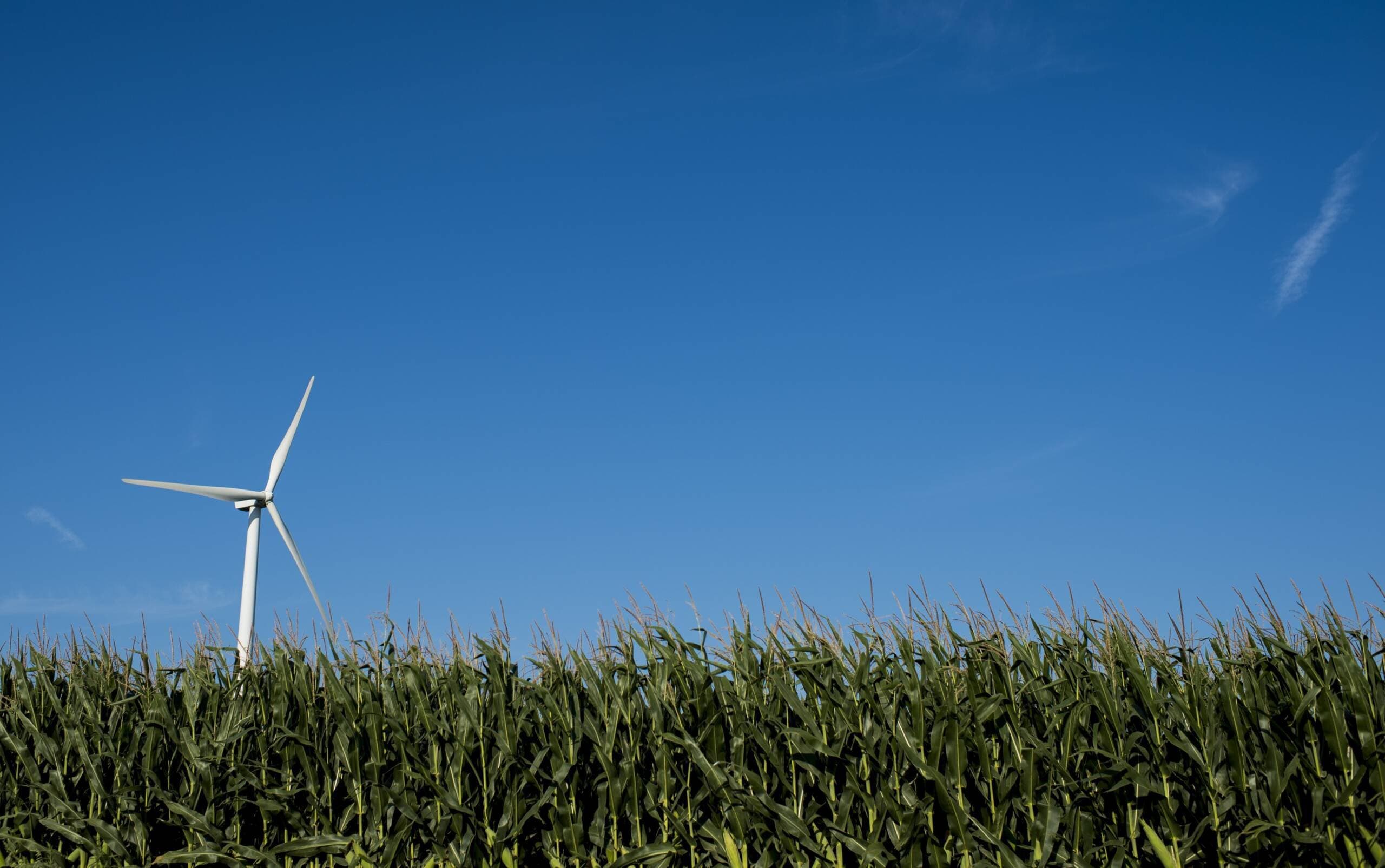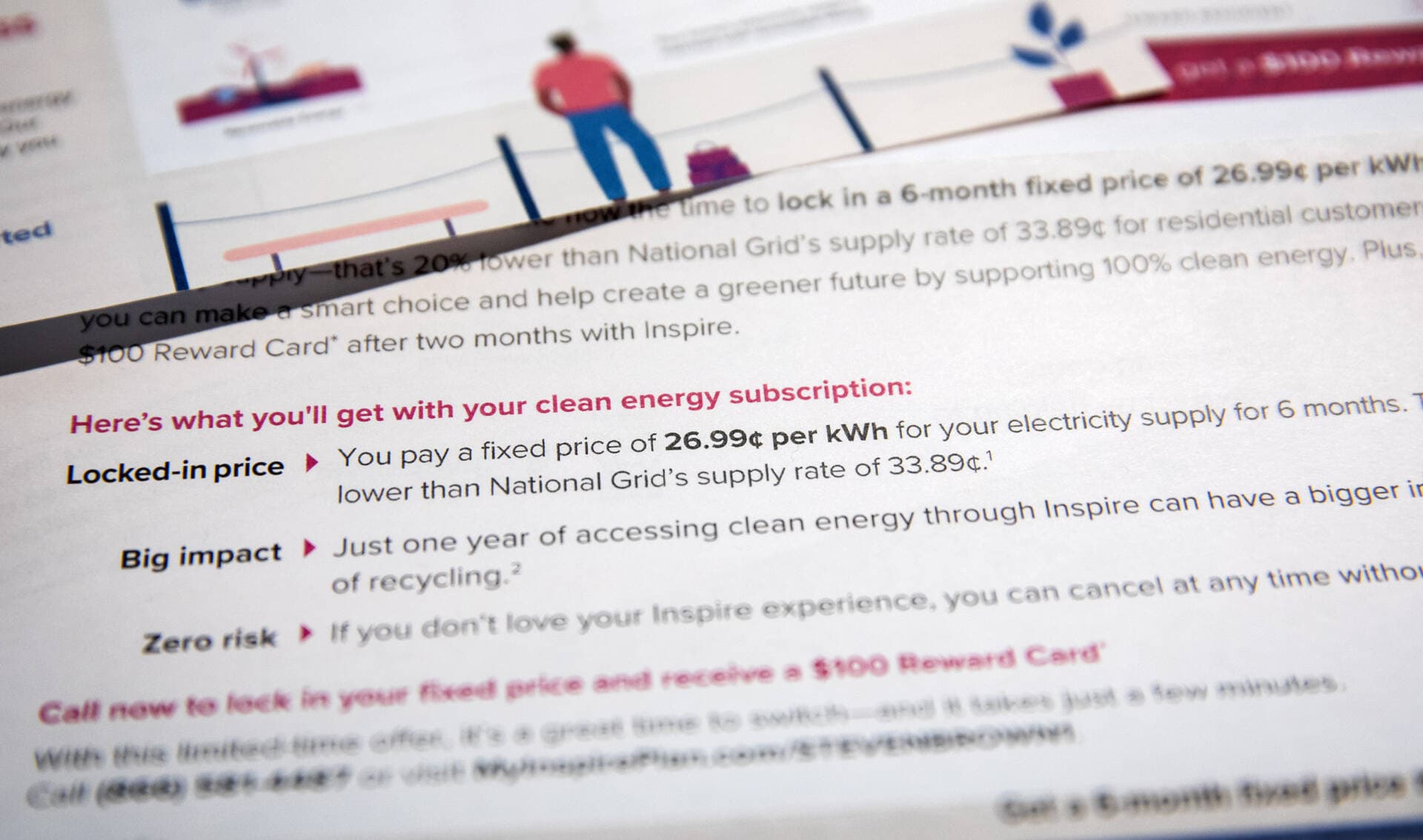
Why '100% renewable electricity' plans may not be as green as you think
There’s a good chance you’ve received flyers in the mail from companies selling 100% renewable energy plans. Maybe you’ve seen an ad online that says you can fight climate change from the comfort of your couch, or a social media post telling you that you can help the planet every time you turn on the lights. It’s easy, these companies say; all you have to do is switch your electricity supplier.
In Massachusetts, residents can choose to buy electricity from a private company instead of a utility like Eversource or National Grid. If you sign up with a so-called competitive supplier, nothing physically changes about your electric service; it’s just that the private company buys power in the wholesale electricity market on your behalf instead of your utility.
Many competitive suppliers promise cheaper electric rates, while others — like CleanChoice Energy, Inspire Clean Energy or Verde Energy — use renewables as a selling point.
So if you sign up, is your toaster suddenly powered entirely by the sun?
“The supply companies, they're not like literally bringing solar power to your home,” said Jenifer Bosco, a senior staff attorney with the National Consumer Law Center. “But you wouldn't necessarily know that from the marketing materials.”
To understand why you don’t suddenly get green electrons coming into your home when you enroll in one of these plans, it’s helpful to picture the New England electric grid as a big lake. There are many streams flowing into it, which are power generators like natural gas plants and wind farms. The water these streams carry represent the electrons these generators produce. Once these streams meet the lake, all of the water gets mixed together. When you turn on your toaster, you're drawing water from the lake; you can’t control which electrons move through the wires and enter your house.
So let’s say you enroll in one of these plans. You might not be using renewable energy when you turn on your lights, but is your supplier actually buying 100% green power?
The answer is: it depends.
To track and verify the renewable power delivered to the grid, states and regulators use a system of “renewable energy credits.” Think of a credit like a token — every time a megawatt hour of renewable energy is produced and delivered to the grid, a credit is generated. When suppliers buy renewable energy, they get the corresponding credits. And after they sell that energy to their customers, they turn in those credits to the state.
Advertisement
In Massachusetts, these renewable energy credits are a key part of the state’s climate plans. That’s because all electric suppliers — utilities and private companies — are required to buy an increasing percentage of their power from renewable energy sources every year. In 2023, suppliers need to buy 22% of their electricity from qualifying renewables. Next year it will be 24%, and by 2030, it will be 40%.
In this system, credits serve two purposes: they're how suppliers prove they’re complying with the mandate, and they incentivize the development of new renewable energy sources. When demand for credits rises, clean energy developers build new wind and solar farms because they know there will be a market for the energy they produce.
As an incentive program, “it has been wildly, wildly successful,” said Elizabeth Mahony, commissioner of the Department of Energy Resources, which oversees the credit tracking system. “We have built quite a bit of onshore wind. We're building offshore wind. We've been very successful in Massachusetts in building solar. And there's been some other creative opportunities out there to build clean energy.”
But not all credits are equal, and not all credits “count” in Massachusetts. The state only accepts and tracks credits from renewable power that feeds directly into the New England grid. So credits from a wind farm in Maine count, but credits from a wind farm in Iowa don't because that power doesn't do anything to decarbonize the New England power grid.
A lot of competitive suppliers, however, go outside of the region to buy wind and solar because it tends to be cheaper there.
“We are tracking everything that any supplier is doing in compliance with our programs — so everything that's required,” Mahony said. “We don’t necessarily know what they’re doing on top of that.”
In other words, once a competitive supplier meets the state's required minimum for locally sourced renewable energy, they can go buy more credits for "green" energy from anywhere, and there's often no way for the state to track these purchases.
“We don't know what they're buying and they are not doing a sufficient job, or really, for the most part, any kind of job of disclosing what they've purchased,” Mahony said.
Some companies will say on their websites where they may buy power from, but there’s no requirement that they disclose detailed information about purchases.
Assuming your supplier is honest about what it’s supplying, does it matter that the renewable energy comes from outside of New England? Well, it gets even more complicated because in many cases, the company is not actually buying renewable electricity from the wholesale power market. It’s buying renewable energy credits to offset the non-renewable electricity it purchases. Using these credits to claim a 100% renewable label is a practice many critics say is greenwashing.
“I think it’s really preying on consumers who are legitimately concerned about the environment,” Bosco of the National Consumer Law Center said. “It’s exploiting that concern to sell an overpriced product that’s really not having the impact that the consumer thinks that it is.”

It’s easy for consumers to be confused because there are two ways for a supplier to claim it's giving you access renewables. Remember those credits? There are actually two types: bundled and unbundled. (No one said this was simple.)
The bundled ones are directly "attached" to the actual megawatt hours of renewable energy. The unbundled ones can be detached from the power they represent and sold in a separate market to suppliers that want more renewable energy credits.
Suppliers in Massachusetts use “bundled” credits to meet their minimum renewable energy requirements. But for competitive suppliers that want to offer higher rates of renewable energy, they can buy the “unbundled” kind. This means that even though the green power never comes to New England, the supplier in Massachusetts uses that unbundled credit to offset the non-renewable power they actually bought and claim they're giving you 100% clean power.
To give an example of how this works, let’s say a supplier in Iowa purchases power from an Iowa wind farm. Because there is so much wind power in the state, that supplier might not need to turn in all the credits it receives to meet a renewable energy requirement. Instead, it might make a little extra money by selling some credits to a Massachusetts supplier that wants more of them.
The problem with this system, critics say, is that purchasing “unbundled” credits does nothing to displace fossil fuels and help Massachusetts meet its climate goals.
That wind farm in Iowa will exist and have a market for its electricity whether or not it generates credits. The same cannot be said for wind or solar farms in New England — they tend to be more expensive to build, and many would not exist without the requirement that suppliers buy their electricity and turn in the associated credits.
“We think that representing to consumers that they're purchasing renewable energy when all they're purchasing is normal electricity plus an unbundled [credit], that can be misleading," said Liz Anderson, deputy chief of the energy and telecommunications division at the Massachusetts Attorney General’s Office.
What’s more, she added, “the renewable energy credits from the cheap wind farm in Iowa are probably so cheap that whatever the premium you're paying for, that is way too much.”
Not everyone thinks buying unbundled credits amounts to greenwashing, though.
Frank Caliva, a spokesman for the Retail Energy Supply Association, an industry group that represents many competitive supply companies, said pairing unbundled credits with electricity “isn’t somehow cheating,” It's an offset, and it sends a signal to the market that there’s demand for renewables.
But Mahony of the Department of Energy Resources said she thinks environmentally-minded people in Massachusetts are often willing to pay extra for clean energy precisely because they want to see more renewables on the grid in New England.
“People who are concerned enough to purchase extra clean energy in their bill when they're making all of their monthly billing choices, I gotta assume that customers really want to be supporting clean energy that impacts their lives directly, that impacts their air,” she said.
“Wind in Iowa is great for folks in Iowa, but it’s not cleaning up our air here. It’s not impacting us directly.”
This segment aired on May 9, 2023.
